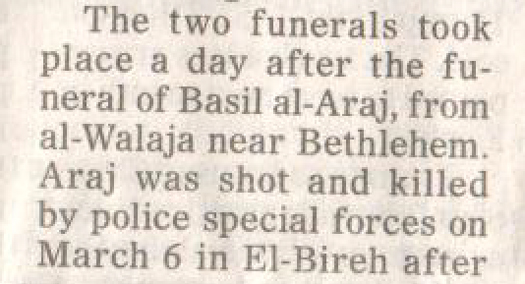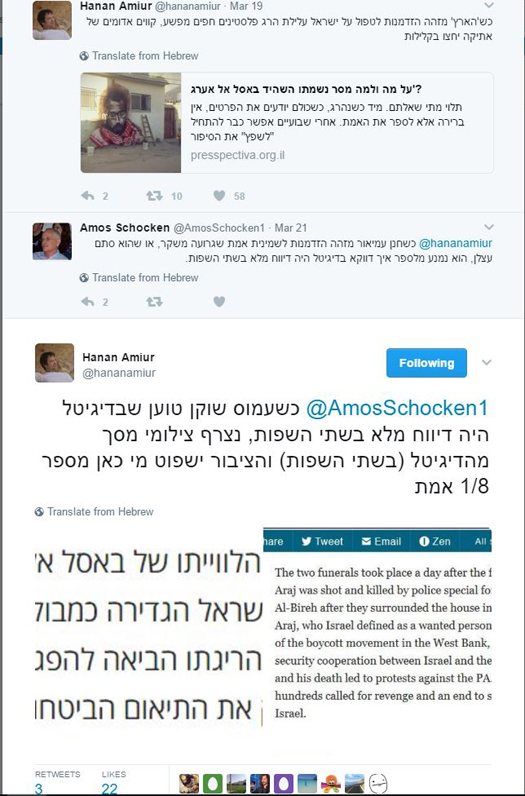Palestinian Basil Al-Araj was buried last Thursday near Bethlehem.
Why was Al-Araj killed in the prime of his youth?
Haaretz readers who saw the article by Jack Khoury and Gili Cohen (“Palestinian teenager shot and killed by IDF forcces near Hebron”) in the March 19 print edition, or March 18 online
here, would understand that Israeli forces killed him because he supported the boycott of Israel and opposed Palestinian security coordination with Israel.
As the online edition stated:
The two funerals took place a day after the funeral of Basil al-Araj. Araj was shot and killed by police special forces on March 6 in Al-Bireh after they surrounded the house in which he was hiding. Araj, who Israel defined as a wanted person, was among the leaders of the boycott movement in the West Bank, and called for an end to security cooperation between Israel and the Palestinian Authority, and his death led to protests against the PA. During the funeral hundreds called for revenge and an end to security cooperation with Israel.
Similarly, the print edition reported:


While the article mentions al-Araj’s support for the boycott movement, both versions – online and in print – fail to mention critical information reported by Gili Cohen and Jacky Khoury earlier this month at the time of the shootout in which Al-Araj was killed (“Palestinian Gunman Killed in West Bank Shootout with Israeli Soldiers,” screen shot follows).

As Cohen and Khoury reported March 6, al-Araj “was the leader of a cell planning attacks and was responsible for acquiring weapons, a statement from the Border Police said.” Why did the March 19 article mention al-Araj’s involvement in the boycott movement but ignore his alleged involvement in planning attacks and acquiring weapons? The latter activities are the cause for the deadly arrest raid. The former is not.
In addition, as Cohen and Khoury reported March 6, but not March 19, al-Araj was killed in an arrest raid, in which the suspect opened fire on Israeli troops. They wrote March 6: “A Palestinian gunman was killed early Monday in an exchange of fire with Israeli security forces during a raid to arrest him. . . ” The later story does not mention that the purpose of the raid was to arrest al-Araj. Nor does it mention that al-Araj opened fire on the police.
Moreover, Cohen and Khoury reported on March 6 that “the Israeli army reported that two M-16 and Carlo rifles were found during a search of al-Araj’s home.” This information also did not appear in the March 19 article, which did find space to mention the irrelevant information that al-Araj was a younger intellectual who supported the boycott movement.
About the March 19 omissions concerning al-Araj’s reported involvement in terror activity, Haaretz news editor Ori Mark told Presspectiva, CAMERA’s Hebrew site:
The Al-Araj case is mentioned as an aside in a news story about the killing of a Palestinian youth. The article stated that Israel regarded him as wanted, and that he was killed in the house in which he was hiding. The article published after he was killed explicitly stated that according to the border police, he was the leader of a cell planning attacks. There is no basis to the claim that Haaretz attempted to misrepresent the circumstances of the incident.
Following Presspectiva’s publication of this post in Hebrew, Haaretz publisher Amos Schocken tweeted in Hebrew: “When [Presspectiva editor-in-chief] Hanan Amiur sees a chance to tell an eighth of the truth, which is worse than a lie, or when he’s plain lazy, he fails to note that the digital edition in both languages carried the full report.”
Amiur responded by posting screen shots of the articles, which in both Hebrew and English ignored the fact that the border police identified al-Araj as the head of a terror cell and were attempting to arrest him when he fired on them. Amiur tweeted: “When Amos Schocken claims that the digital editions of both languages carried full reports, we will provide screen shots from the digital edition (in two languages) and the public will decide who is telling one-eighth of the truth.”

For the Hebrew version of this post, please visit Presspectiva.




